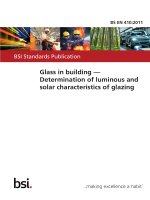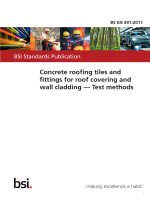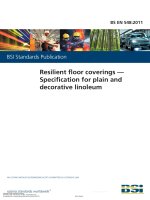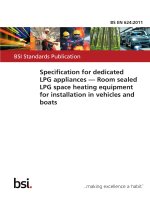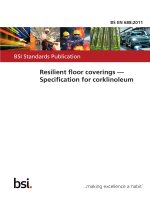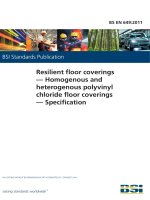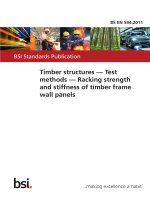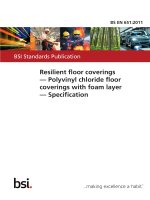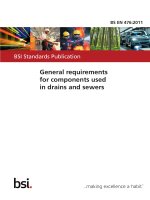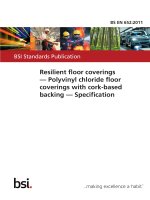Bsi bs en 62006 2011
Bạn đang xem bản rút gọn của tài liệu. Xem và tải ngay bản đầy đủ của tài liệu tại đây (3.13 MB, 114 trang )
BS EN 62006:2011
BSI Standards Publication
Hydraulic machines —
Acceptance tests of small
hydroelectric installations
NO COPYING WITHOUT BSI PERMISSION EXCEPT AS PERMITTED BY COPYRIGHT LAW
raising standards worldwide™
BS EN 62006:2011 BRITISH STANDARD
National foreword
This British Standard is the UK implementation of EN 62006:2011. It is
identical to IEC 62006:2010.
The UK participation in its preparation was entrusted to Technical Committee
MCE/15, Hydraulic turbines.
A list of organizations represented on this committee can be obtained on
request to its secretary.
This publication does not purport to include all the necessary provisions of a
contract. Users are responsible for its correct application.
© BSI 2011
ISBN 978 0 580 54423 1
ICS 27.140
Compliance with a British Standard cannot confer immunity from
legal obligations.
This British Standard was published under the authority of the Standards
Policy and Strategy Committee on 30 June 2011.
Amendments issued since publication
Amd. No. Date Text affected
EUROPEAN STANDARD EN 62006 BS EN 62006:2011
NORME EUROPÉENNE
EUROPÄISCHE NORM February 2011
ICS 27.140 English version
Hydraulic machines -
Acceptance tests of small hydroelectric installations
(IEC 62006:2010)
Machines hydrauliques - Hydraulische Maschinen -
Essais de réception des petits Abnahmemessungen an Kleinwasserkraft-
aménagements hydroélectriques Anlagen
(CEI 62006:2010) (IEC 62006:2010)
This European Standard was approved by CENELEC on 2011-01-02. CENELEC members are bound to comply
with the CEN/CENELEC Internal Regulations which stipulate the conditions for giving this European Standard
the status of a national standard without any alteration.
Up-to-date lists and bibliographical references concerning such national standards may be obtained on
application to the Central Secretariat or to any CENELEC member.
This European Standard exists in three official versions (English, French, German). A version in any other
language made by translation under the responsibility of a CENELEC member into its own language and notified
to the Central Secretariat has the same status as the official versions.
CENELEC members are the national electrotechnical committees of Austria, Belgium, Bulgaria, Croatia, Cyprus,
the Czech Republic, Denmark, Estonia, Finland, France, Germany, Greece, Hungary, Iceland, Ireland, Italy,
Latvia, Lithuania, Luxembourg, Malta, the Netherlands, Norway, Poland, Portugal, Romania, Slovakia, Slovenia,
Spain, Sweden, Switzerland and the United Kingdom.
CENELEC
European Committee for Electrotechnical Standardization
Comité Européen de Normalisation Electrotechnique
Europäisches Komitee für Elektrotechnische Normung
Management Centre: Avenue Marnix 17, B - 1000 Brussels
© 2011 CENELEC - All rights of exploitation in any form and by any means reserved worldwide for CENELEC members.
Ref. No. EN 62006:2011 E
BS EN 62006:2011
EN 62006:2011 - 2 -
Foreword
The text of document 4/254/FDIS, future edition 1 of IEC 62006, prepared by IEC TC 4, Hydraulic
turbines, was submitted to the IEC-CENELEC parallel vote and was approved by CENELEC as
EN 62006 on 2011-01-02.
Attention is drawn to the possibility that some of the elements of this document may be the subject of
patent rights. CEN and CENELEC shall not be held responsible for identifying any or all such patent
rights.
The following dates were fixed:
– latest date by which the EN has to be implemented (dop) 2011-10-02
at national level by publication of an identical
national standard or by endorsement
– latest date by which the national standards conflicting (dow) 2014-01-02
with the EN have to be withdrawn
Annex ZA has been added by CENELEC.
__________
Endorsement notice
The text of the International Standard IEC 62006:2010 was approved by CENELEC as a European
Standard without any modification.
In the official version, for Bibliography, the following notes have to be added for the standards indicated:
IEC 60994 NOTE Harmonized as EN 60994.
IEC 61116 NOTE Harmonized as EN 61116.
IEC 61260 NOTE Harmonized as EN 61260.
ISO 4373 NOTE Harmonized as EN ISO 4373.
ISO 5167 series NOTE Harmonized in EN ISO 5167 series (not modified)
__________
BS EN 62006:2011
- 3 - EN 62006:2011
Annex ZA
(normative)
Normative references to international publications
with their corresponding European publications
The following referenced documents are indispensable for the application of this document. For dated
references, only the edition cited applies. For undated references, the latest edition of the referenced
document (including any amendments) applies.
NOTE When an international publication has been modified by common modifications, indicated by (mod), the relevant EN/HD
applies.
Publication Year Title EN/HD Year
IEC 60041 1991 1994
IEC 60193 - Field acceptance tests to determine the EN 60041 -
IEC 60308 - hydraulic performance of hydraulic turbines, -
IEC 60609 Series storage pumps and pump-turbines Series
IEC 60651 - -
IEC 61362 - Hydraulic turbines, storage pumps and EN 60193 -
ISO 1680 - pump-turbines - Model acceptance tests -
ISO 1940-1 2003 -
Hydraulic turbines - Testing of control EN 60308
ISO 3746 - systems -
ISO 4412 Series Hydraulic turbines, storage pumps and EN 60609 -
ISO 5168 - -
ISO 7919-5 - pump-turbines - Cavitation pitting evaluation -
ISO 10816-3 - Sound level meters EN 60651 -
Guide to specification of hydraulic turbine EN 61362
control systems
Acoustics - Test code for the measurement EN ISO 1680
of airborne noise emitted by rotating electrical
machines
Mechanical vibration - Balance quality -
requirements for rotors in a constant (rigid)
state -
Part 1: Specification and verification of
balance tolerances
Acoustics - Determination of sound power EN ISO 3746
levels of noise sources using sound pressure -
Survey method using an enveloping
measurement surface over a reflecting plane
Hydraulic fluid power - Test code for -
determination of airborne noise levels
Measurement of fluid flow - Estimation of -
uncertainly of a flow-rate measurement
Mechanical vibration - Evaluation of machine -
vibration by measurements on rotating shafts -
Part 5: Machine sets in hydraulic power
generating and pumping plants
Mechanical vibration - Evaluation of machine -
vibration by measurements on non-rotating
parts -
Part 3: Industrial machines with nominal
power above 15 kW and nominal speeds
between 120 r/min and 15 000 r/min when
measured in situ
BS EN 62006:2011
EN 62006:2011 - 4 -
Publication Year Title EN/HD Year
ANSI/IEEE 810 - - -
Hydraulic Turbine and Generator Integrally
Forged Shaft Couplings and Shaft Runout
Tolerances
– 2 – BS EN 62006:2011
62006 © IEC:2010
CONTENTS
1 Scope ...............................................................................................................................................9
2 Normative references ....................................................................................................................9
3 Terms, definitions and schematic layout . .................................................................................10
3.1 Terms and definitions . ......................................................................................................10
3.2 Schematic layout of a hydroelectric installation . .......................................................... 10
4 Nature and extent of guarantees. ..............................................................................................11
4.1 Grouping of classes A, B, C. ............................................................................................11
4.1.1 General . ................................................................................................................11
4.1.2 Contract conditions. .............................................................................................13
4.2 Scope of performance guarantee. ...................................................................................13
4.2.1 General . ................................................................................................................13
4.2.2 Class A: Maximum power output. .......................................................................13
4.2.3 Class B: Index test . .............................................................................................13
4.2.4 Class C: Turbine efficiency . ................................................................................13
4.2.5 Interpretation of losses . ......................................................................................13
4.3 Scope of tests ....................................................................................................................14
4.3.1 Safety tests ...........................................................................................................14
4.3.2 Trial run and reliability tests................................................................................14
4.3.3 Performance test ..................................................................................................14
4.4 Aptitude. ..............................................................................................................................15
4.5 Warranty .............................................................................................................................15
5 Safety tests (commissioning) . ....................................................................................................16
5.1 Pre-start tests ....................................................................................................................16
5.2 Closing devices . ................................................................................................................16
5.2.1 General . ................................................................................................................16
5.3 5.2.2 Intake gate or valve . ............................................................................................17
5.4 5.2.3 Turbine inlet valve . ..............................................................................................17
5.5 5.2.4 Guide vanes (Francis and Kaplan turbines) . ................................................... 17
5.6 5.2.5 Needle valve and deflector (Pelton and Turgo turbines) . ............................... 18
5.7 First run operation and control.........................................................................................19
5.8 Bearing run at rated speed . .............................................................................................19
5.9 Emergency shutdown (no load) . .....................................................................................20
Electrical protection...........................................................................................................20
5.10 Overspeed test ...................................................................................................................21
Runaway test . ....................................................................................................................21
Overpressure, emergency trip and load rejection tests . ............................................. 22
5.9.1 General conditions . .............................................................................................22
5.9.2 Testing the guide vanes or needle valves . .......................................................23
5.9.3 Testing the turbine inlet valve . ...........................................................................23
5.9.4 Testing the pressure relief valve . .......................................................................23
5.9.5 Pressure rise . .......................................................................................................23
Measured quantities . ........................................................................................................25
5.10.1 Pressure. ...............................................................................................................25
5.10.2 Speed. ....................................................................................................................25
5.10.3 Control components. ............................................................................................25
BS EN 62006:2011 – 3 –
62006 © IEC:2010
6 Trial operating and reliability tests (commissioning)...............................................................25
6.1 General . ..............................................................................................................................25
6.2 Temperature stability of rotating parts . ..........................................................................25
6.2.1 General . ................................................................................................................25
6.2.2 Temperature guarantees . ...................................................................................26
6.3 Speed controller system . ..................................................................................................26
6.3.1 General . ................................................................................................................26
6.3.2 Unit operating without regulation .......................................................................26
6.3.3 Unit operating with a speed governor. ...............................................................27
6.3.4 Unit operating with a voltage governor . ............................................................ 28
6.3.5 Unit operating with a controller . .........................................................................28
6.3.6 Measurements when testing the control system . ............................................ 28
6.4 Control of cam correlation . ..............................................................................................29
7 Performance guarantees and tests . ..........................................................................................29
7.1 General . ..............................................................................................................................29
7.2 Maximum generator (transformer) power output as a function of net head .............. 30
7.2.1 Guarantee . ............................................................................................................30
7.2.2 Instrumentation. ....................................................................................................30
7.3 Index test ............................................................................................................................30
7.3.1 General . ................................................................................................................30
7.3.2 Index discharge measurement . ..........................................................................31
7.3.3 Shape control . ......................................................................................................31
7.3.4 Index plant efficiency . ..........................................................................................32
7.3.5 Optimizing cam correlation . ................................................................................33
7.4 Turbine efficiency . .............................................................................................................33
7.4.1 Efficiency test by absolute discharge measurement ....................................... 33
7.4.2 Efficiency test by thermodynamic method . .......................................................34
7.5 Correcting the efficiency using the model curve. .......................................................... 34
8 Computation of results and comparison to the guarantee. .................................................... 36
8.1 General . ..............................................................................................................................36
8.1.1 Site data . ...............................................................................................................36
8.1.2 Measured values (readings) . .............................................................................36
8.1.3 Scale effect due to water temperature . ............................................................ 37
8.1.4 Shifting of the plant characteristic . ....................................................................37
8.2 Power output . .....................................................................................................................37
8.2.1 Plant power output measurement . ...................................................................37
8.2.2 Generator power output measurement . ............................................................ 38
8.2.3 Turbine power output measurement.................................................................. 38
8.3 Relative turbine efficiency (index test) . ..........................................................................38
8.3.1 General . ................................................................................................................38
8.3.2 Relative discharge . ..............................................................................................38
8.3.3 Guarantee of the shape of the plant characteristics ....................................... 39
8.3.4 Relative index plant efficiency . ..........................................................................40
8.4 Absolute turbine efficiency . .............................................................................................40
8.4.1 General . ................................................................................................................40
8.4.2 Absolute discharge . .............................................................................................40
8.4.3 Guarantee of the plant efficiency and comparison to the results ..................40
9 Error analysis . ..............................................................................................................................40
– 4 – BS EN 62006:2011
62006 © IEC:2010
9.1 General . ..............................................................................................................................40
9.2 Estimation of systematic (bias) uncertainties . ...............................................................41
9.2.1 General . ................................................................................................................41
9.2.2 Typical systematic uncertainties . ...................................................................... 41
9.2.3 Systematic uncertainty for turbines used to indicate discharge ....................42
9.3 Estimation of random (precision) uncertainties . ........................................................... 42
9.3.1 Measurement at a single operation point . ........................................................42
9.3.2 Measurement over a range of operating condition . ........................................ 44
9.4 Evaluation of the uncertainties . ......................................................................................45
9.4.1 General . ................................................................................................................45
9.4.2 Head . .....................................................................................................................45
9.4.3 Power output . .......................................................................................................47
9.4.4 Index test measurement . ....................................................................................49
9.4.5 Efficiency test by absolute discharge measurement ....................................... 51
9.4.6 Efficiency test by the thermodynamic method . ................................................51
10 Other guarantees . .......................................................................................................................51
10.1 Cavitation ............................................................................................................................51
10.1.1 General . ................................................................................................................51
10.1.2 Measurement methods . ......................................................................................52
10.1.3 Comparison with specified guarantees..............................................................52
10.2 Noise . .................................................................................................................................53
10.2.1 General . ................................................................................................................53
10.2.2 Measurement methods . ......................................................................................53
10.2.3 Comparison with specified guarantees..............................................................54
10.3 Vibration. .............................................................................................................................54
10.3.1 General . ................................................................................................................54
10.3.2 Measurements and measurement methods . .................................................... 54
10.3.3 Comparison with specified guarantees..............................................................55
Annex A (normative) Terms, definitions, symbols and units. ...................................................... 56
Annex B (normative) Head definition . .............................................................................................64
Annex C (normative) Method of speed measurements . .............................................................. 77
Annex D (normative) Power output measurement . .......................................................................78
Annex E (normative) Methods of discharge measurement . .........................................................82
Annex F (informative) Plant condition . ...........................................................................................95
Annex G (informative) Commissioning . ..........................................................................................97
Annex H (informative) Performance test efficiency calculation .................................................. 99
Annex I (informative) Cam correlation test . ................................................................................ 106
Bibliography. ..................................................................................................................................... 109
Figure 1 – Schematic layout of a hydroelectric installation (water to wire system) ...................11
Figure 2 – Warranty period . ..............................................................................................................16
Figure 3 – Vanes and blades servomotors force measurements (Kaplan on line) . .................. 17
Figure 4 – Evaluation of the guide vane (GV) closing characteristic . ......................................... 18
Figure 5 – Needle servomotor force .................................................................................................18
Figure 6 – Automatic start – Synchronization – No load test (Kaplan turbine)...........................19
Figure 7 – Emergency shutdown from no load test (Kaplan turbine) . ......................................... 20
BS EN 62006:2011 – 5 –
62006 © IEC:2010
Figure 8 – Runaway test (Kaplan turbine) . .....................................................................................21
Figure 9 – Emergency shutdown due to an electrical fault . .......................................................... 22
Figure 10 – Emergency shutdown due to a mechanical fault . ......................................................23
Figure 11 – Emergency shutdown due to the governor failure .....................................................24
Figure 12 – Evaluation of the maximum overpressure . .................................................................24
Figure 13 – Temperature stability, recording at no load up to stable conditions . ......................26
Figure 14 – Speed governor check at no load ................................................................................27
Figure 15 – Maximum power output: procedure to compare measured power output at
actual net head to the guarantee. .....................................................................................................30
Figure 16 – Comparison of the shape of the turbine characteristic to the guarantee . ..............32
Figure 17 – Example of an optimized switch band for 1 and 2 turbine operation ...................... 33
Figure 18 – Efficiency test: procedure to compare guaranteed turbine efficiency to the
prototype measurement results, including the overall uncertainties . .......................................... 34
Figure 19 – Hill chart – Showing head loss examples with one and two units in
operation using the same penstock ..................................................................................................35
Figure 20 – Shifting of the performance curves . ............................................................................37
Figure 21 – Variation of factor k and exponent x on turbine index efficiency. ........................... 39
Figure 22 – Random uncertainties of a single operation point, example for penstock
pressure variation and fluctuation . ...................................................................................................43
Figure 23 – Detection of outlier errors: example to find out offset and reading errors
by plotting in linear and logarithmic form with the same data. ......................................................44
Figure 24 – Example of scattered points with function of second order . ................................... 44
Figure 25 – Scattered points smoothed by individual fitting on adjacent sections . .................. 45
Figure 26 – Overall uncertainty of head for free water level for low head turbines . ................. 46
Figure 27 – Overall uncertainty of head in a closed conduit . .......................................................47
Figure 28 – Estimated overall uncertainties of the discharge by index measurement
versus full scale differential pressure . .............................................................................................50
Figure 29 – Operation range and cavitation limits . ........................................................................52
Figure A.1 – Transient pressure fluctuation at the turbine high pressure reference
section, when a specified load is suddenly rejected . .................................................................... 61
Figure A.2 – Transient pressure fluctuation at the turbine high pressure reference
section, when a specified load is suddenly accepted. ................................................................... 62
Figure B.1 – High pressure reference and measuring sections . .................................................. 65
Figure B.2 – Measuring section at tail water. ..................................................................................66
Figure B.3 – Measuring section at draft tube . .................................................................................66
Figure B.4 – Definition of measuring sections ................................................................................67
Figure B.5 – Kaplan turbine with horizontal shaft . .........................................................................68
Figure B.6 – Kaplan turbine with vertical shaft . .............................................................................68
Figure B.7 – Francis open flume turbine with vertical shaft . ........................................................69
Figure B.8 – Francis turbine with horizontal shaft. .........................................................................69
Figure B.9 – Francis turbine with vertical shaft, with stagnation probe . .....................................70
Figure B.10 – Francis turbine with horizontal shaft with pressure on suction side. .................. 70
Figure B.11 – Pelton turbine with horizontal shaft . ........................................................................71
Figure B.12 – Pelton turbine with vertical shaft . ............................................................................71
Figure B.13 – Turgo turbine with horizontal shaft . .........................................................................72
Figure B.14 – Turgo turbine with vertical shaft . .............................................................................72
– 6 – BS EN 62006:2011
62006 © IEC:2010
Figure B.15 – Crossflow turbine with horizontal shaft, with draft tube ........................................ 73
Figure B.16 – Crossflow turbine with horizontal shaft, without draft tube . ................................. 73
Figure B.17 – Specifications for static pressure taps . ................................................................... 74
Figure B.18 – Example: discharge versus guide vane opening . .................................................. 76
Figure C.1 – Overspeed and runaway . ............................................................................................77
Figure D.1 – Typical losses of a synchronous generator ..............................................................79
Figure D.2 – Asynchronous generator: typical power factor and slip factor ............................... 80
Figure D.3 – Power measurement using the two wattmeter method. .......................................... 80
Figure D.4 – Power measurement using the three wattmeter method ........................................ 81
Figure E.1 – Typical arrangements of acoustic transducers . ...................................................... 84
Figure E.2 – Arrangement for pressure time method . ................................................................... 85
Figure E.3 – Example of pressure-time diagram for a uniform conduit ....................................... 86
Figure E.4 – Example of pressure-time diagram for a non-uniform conduit ............................... 86
Figure E.5 – Example of pressure-time diagram for a combination of uniform and non
uniform conduits between several sections . ...................................................................................87
Figure E.6 – Location of taps for differential pressure method of discharge measurement . ...93
Figure E.7 – Location of taps for differential pressure measurement of discharge in a
bulb turbine . ........................................................................................................................................93
Figure E.8 – Location of taps for Winter-Kennedy method of discharge measurement
through a turbine equipped with a steel spiral case .......................................................................94
Figure H.1 – Comparison of measured index efficiency with the guaranteed values . .......... 105
Figure I.1 – Index measurement to optimize the efficiency . ...................................................... 107
Figure I.2 – Two dimensional cam correlation . ............................................................................ 108
Table 1 – Scope of classes A, B, and C ..........................................................................................12
Table 2 – Maximum runaway speeds (nrun) expressed as a percentage of rated speed . ....... 21
Table 3 – Performance test parameters . .........................................................................................29
Table 4 – Index discharge measurement methods . ...................................................................... 31
Table 5 – Site data .............................................................................................................................36
Table 6 – Systematic uncertainties at full load . .............................................................................41
Table 7 – Systematic uncertainties of discharge versus turbine opening . ................................. 42
Table 8 – Overall uncertainties of the shape of turbine characteristics with respect to
the guaranteed efficiency ...................................................................................................................49
Table 9 – Data used in Figure 28 . ....................................................................................................51
Table 10 – Limits for cavitation damage . .........................................................................................53
Table A.1 – Density of water . ............................................................................................................62
Table E.1 – Selection of flow measurement method . .................................................................... 82
Table E.2 – Evaluation of the penstock factor with estimation of the systematic uncertainty. .91
Table H.1 – Plant index efficiency guarantee . ................................................................................99
Table H.2 – Transformer data . ....................................................................................................... 100
Table H.3 – Data measurements (not all tests included) . .......................................................... 101
Table H.4 – Calculation of results . ................................................................................................ 102
BS EN 62006:2011 – 9 –
62006 © IEC:2010
HYDRAULIC MACHINES – ACCEPTANCE TESTS
OF SMALL HYDROELECTRIC INSTALLATIONS
1 Scope
This International Standard defines the test, the measuring methods and the contractual
guarantee conditions for field acceptance tests of the generating machinery in small
hydroelectric power installations. It applies to installations containing impulse or reaction
turbines with unit power up to about 15 MW and reference diameter of about 3 m. The driven
generator can be of synchronous or asynchronous type.
This International Standard contains information about most of the tests required for
acceptance of the hydraulic turbine such as safety approval tests, trial operating and reliability
tests, as well for verification of cavitation, noise and vibration conditions, if required.
This standard represents the typical methods used on smaller hydroelectric installations, and
is divided into three classes as follows (see Table 1 for more detail):
Class A Normal test program (panel measurement) Default
Class B To determine the maximum power output of the Recommended
Class C installation.
Optional
Extended test program
To determine the performance characteristics of the
installation.
Comprehensive test program
To determine the absolute efficiency of the installation.
NOTE All classes contain safety tests, trial operating tests, and reliability tests.
This standard gives all necessary references for the contract in order to execute the test,
evaluate, calculate and compare the result to the guarantee for all the classes A, B and C.
The manufacturer or consulting engineer is responsible for ensuring that standardized
connections are installed for performing these tests. This standard does not cover the
structural details of a hydroelectric installation or its component parts.
2 Normative references
The following referenced documents are indispensable for the application of this document.
For dated references, only the edition cited applies. For undated references, the latest edition
of the referenced document (including any amendments) applies.
IEC 60041:1991, Field acceptance tests to determine the hydraulic performance of hydraulic
turbines, storage pumps and pump turbines
IEC 60193, Hydraulic turbines, storage pumps and pump-turbines – Model acceptance tests
IEC 60308, Hydraulic turbines – Testing of control systems
IEC 60609 (all parts), Hydraulic turbines, storage pumps and pump-turbines – Cavitation
pitting evaluation
IEC 60651, Specification for sound level meters
– 10 – BS EN 62006:2011
62006 © IEC:2010
IEC 61362, Guide to specification of hydraulic turbine control systems
ISO 1680 Acoustics – Test code for the measurement of airborne noise emitted by rotating
electrical machinery
ISO 1940-1:2003, Mechanical vibration – Balance quality requirements for rotors in a
constant (rigid) state – Part 1: Specification and verification of balance tolerances
ISO 3746, Acoustics – Determination of sound power levels of noise sources using sound
pressure – Survey method using an enveloping measurement surface over a reflecting plane
ISO 4412 (all parts), Hydraulic fluid power – Test code for determination of airborne noise
levels
ISO 5168, Measurement of fluid flow – Procedures for the evaluation of uncertainties
ISO 7919-5, Mechanical vibration – Evaluation of machine vibration by measurements on
rotating shafts – Part 5: Machine sets in hydraulic power generating and pumping plants
ISO 10816-3, Mechanical vibration – Evaluation of machine vibration by measurements on
non-rotating parts – Part 3: Industrial machines with nominal power above 15 kW and nominal
speeds between 120 r/min and 15 000 r/min when measured in situ
ANSI/IEEE 810, Hydraulic Turbine and Generator Integrally Forged Shaft Couplings and
Shaft Runout Tolerances
3 Terms, definitions and schematic layout
3.1 Terms and definitions
A complete list of terms and definitions is given in Annex A.
3.2 Schematic layout of a hydroelectric installation
In general, there are three connected hydraulic regimes in a hydroelectric installation as
shown in Figure 1 below. These are the upstream water passage, the turbine guarantee
domain, and the downstream water passage.
BS EN 62006:2011 – 11 –
62006 © IEC:2010
Head water level
(HWL)
Pout
PL,tf U2 Transformer
Generator
Hg (gross head)
U1
Pgen Exciter (PL,ex)
electr./mech.
PL,gn E- el Auxiliary device (PL,ax)
E-mech Sub system
PL,ax
PL,tr Transmission (gear/belt)
Turbine bearing
Pt Tail water level
(TWL)
Turbine setting
level
Upstream Discharge
water passage
z 0 Turbine Downstream z 2 z 3
z 1 Turbine guarantee domain water passage
z T
High pressure Low pressure
reference section 1 reference section 2
Reference datum
NOTE The losses in the upstream and downstream water passage are not part of the turbine losses.
Nevertheless, they may influence the hydraulic conditions in the turbine guarantee domain and lower the efficiency
of the turbine. Only the energy losses in the turbine guarantee section are to be considered when measuring the
efficiency of a turbine. If it is not possible to measure the energy in the reference section 1 and 2, the measuring
section should be changed in agreement with all parties.
The definition of the reference section 1 and 2 and that of net head and specific energy for the most common small
turbines is given in Annex B.
Figure 1 – Schematic layout of a hydroelectric installation (water to wire system)
4 Nature and extent of guarantees
4.1 Grouping of classes A, B, C
4.1.1 General
The scope of the measurement classes for hydroelectric installations is shown in Table 1.
– 12 – BS EN 62006:2011
62006 © IEC:2010
Class A Table 1 – Scope of classes A, B, and C
Class B
Class C Normal (panel measurement) test program
Extended test program
Comprehensive test program
Measurement of class C B A Clause
5
Safety tests (commissioning) yes yes yes 5.1
yes yes yes 5.2
Pre-start tests (dry test) yes yes yes 5.3
yes yes yes 5.4
Closing devices (dry and wet tests) yes yes yes 5.5
yes yes yes 5.6
First run operation and control (wet tests) yes yes yes 5.7
no/opt no/opt no/opt 5.8
Bearing run at rated speed yes yes yes 5.9
Emergency shutdown (no load)
Electrical protection
Overspeed test
Runaway test
Overpressure, emergency trip and load rejection tests
Trial operating and reliability tests (commissioning) 6
Temperature stability of rotating parts yes yes yes 6.2
Speed controller system yes/opt yes/opt yes/opt 6.3
Control of cam correlation (double regulated turbines) yes yes yes 6.4
Performance guarantees and tests 7
Maximum generator (transformer) power output
Index test a a yes 7.2
- Shape control
- Index plant efficiency 7.3
- Optimizing cam correlation
Turbine efficiency a yes – 7.3.3
- Absolute discharge measurement
- Thermodynamic method a yes – 7.3.4
a a a 7.3.5
7.4
yes – – 7.4.1
yes – – 7.4.2
Computation of results and comparison to the guarantee yes yes yes 8
yes 9
Error analysis yes yes 10
yes/opt 10.1
Other guarantees no/opt 10.2
no/opt 10.3
Cavitation yes/opt yes/opt
Noise no/opt no/opt
Vibration no/opt no/opt
NOTE Definitions used in Table 1 are the following:
yes – may be required.
yes/opt(ional) – normally yes, but depends on the turbine type and site conditions.
no/opt(ional) – normally no, but depends on the turbine type and site conditions.
a included in other tests.
– not required.
BS EN 62006:2011 – 13 –
62006 © IEC:2010
4.1.2 Contract conditions
The contract specifies the guarantees, and includes the scope of the tests, and the
classification of measuring instruments. Safety tests shall always be included. The condition
of the plant, water quality, and setting levels shall all be specified (see Annex F).
4.2 Scope of performance guarantee
4.2.1 General
All guarantees concern the hydraulic passage between reference section 1 and 2 (turbine
guarantee domain) and the corresponding net head. The guaranteed data required for each
class is given below:
4.2.2 Class A: Maximum power output Pgen, max = f (H)
Pout, max = f (H)
a) Maximum power output of the generator, including losses a) to
d) of 4.2.5
b) Maximum power output of the transformer, including losses a) to
e) of 4.2.5
• Power output versus net head, see Figure 15
• Discharge versus turbine opening, see Figure B.18
• Electrical connection sheet, see Annex D
4.2.3 Class B: Index test
Shape control of turbine characteristic for newly commissioned turbines, and for
refurbishment projects to compare pre- and post- refurbishment measurements.
a) Shape control ηix = f (Pt)
• Expected shape of plant efficiency, see Figure 16
• Possible deviation to the shape, see Figure 16
• Hill chart if the head differs by more than 3 %, see Figure 19
b) Index plant efficiency η plant Ix = f (Pout)
• Hill chart, see Figure 19
• Generator losses, see Annex D
• Electrical connection sheet, see Annex D
c) Optimizing of cam correlation for double regulated turbines
• Pre-adjusted opening of guide vane versus runner blade opening as a function of
static head, see Annex I
4.2.4 Class C: Turbine efficiency
a) Absolute discharge measurement ηt = f (Pt)
b) Thermodynamic method ηt = f (Pt)
• Hill chart, see Figure 19
• Generator losses, see Annex D
• Electrical connection sheet, see Annex D
4.2.5 Interpretation of losses
The parties shall agree on interpretation of losses due to the following mechanical and
electrical equipment:
a) turbine bearings and additional equipment;
– 14 – BS EN 62006:2011
62006 © IEC:2010
b) mechanical power transmission devices such as gears and belts;
c) generator including bearings, excitation system, mechanically driven or electrically
connected auxiliaries;
d) mechanically or electrically driven auxiliaries;
e) transformer.
The following subsystems and devices are excluded from consideration:
f) devices which are needed for dewatering (mud pumps);
g) temporary heating and / or cooling systems;
h) any lights.
4.3 Scope of tests
4.3.1 Safety tests
If testing reveals that operation of the unit is not safe, then no further operation of the plant
may be continued, until such deficiency is located, evaluated and repaired.
4.3.2 Trial run and reliability tests
When all the safety tests are completed, and within the allowable limits, the time limited trial
run can be started. The duration of the trial run is normally at least 72 h.
4.3.3 Performance test
4.3.3.1 General test condition
a) Method of measurement: the methods to be used for the measurement or computation of
discharge, power, head, efficiency, speed, and losses shall be stated in the general
procedure (see Clauses 7, 8, and 9).
b) Number of points, runs and readings: a performance curve such as the ones shown in
Figure 15 (class A), Figure 16 (class B), and Figure 18 (class C) requires a minimum of
six and preferably eight or ten points. Each point will be obtained from one or more runs
(see Figure 25 and Table H.4). The number of measurements taken during a run depends
upon the methods of measurement used. To eliminate outliers, at least three runs are to
be taken over an agreed time or over the duration of any time-based measurement.
c) The interval of time used for instrument recording shall generally be the same for each
variable.
d) Small hydro turbines are often built from standard components. Care shall be taken to
avoid operating the turbine above its maximum power (see Figure 15).
4.3.3.2 Test condition to be fulfilled
a) Fluctuations and variations during a run (see Figure 22, Figure 23, and Figure 24).
Fluctuations are defined as high frequency changes, of more than 1 Hz, in the values of
head, power output, discharge and rotational speed about average values. They are often
caused by head and pressure variation in the peripheral areas such as the river, canal,
reservoir, penstock, and outlet channel. Variations are longer period changes or trends.
b) The extreme variation of power shall not exceed ±1,5 % of the average value of power.
c) The extreme variation of head (pressure) shall not exceed ±0,5 % of the average of value
of head (pressure).
d) The extreme variation of rotational speed shall not exceed ±0,5 % of the average of value
of rotational speed.
BS EN 62006:2011 – 15 –
62006 © IEC:2010
4.3.3.3 General check after the tests
The preliminary computation of the test results shall be made at site. If the plant appears to
fail its guarantee, steps shall be taken to identify the cause before disconnecting the
instrumentation.
a) Check the data for errors, and recalculate the results if any errors are found.
b) Check all the instrumentation for correct connection, calibration, absence of air in the
measuring pipes, and for irregular fluctuations.
c) Check for random errors and outliers.
d) Check for any hydraulic failure within the waterway such as the inflow conditions.
e) Check for suspended particles within the turbine such as grass, algae, or industrial fibre,
etc. (stop the turbine, and clean the turbine and the water passages).
f) Check of the reference levels.
g) Check of the unit for any abnormal hydraulic and/or electrical behaviour.
h) Check for possible air release at the draft tube outlet.
i) Investigate unexpected vibrations and/or noise level.
j) Verify the equipment set-up and the flow passage geometry:
• turbine opening in closed and full opened position, check for any signal offset;
• cam correlation (double regulated turbines);
• deflector correlation to needle opening;
• runner geometry.
After this investigation, the chief of tests shall make a short report to indicate the possible
reason for failure. The manufacturer shall have the right to inspect the dewatered turbine and
the upstream and downstream water passages at this time.
4.4 Aptitude
All parties shall have confidence in the test team with respect to responsibility and
competence when testing the unit under critical conditions. Commissioning engineers shall
normally carry out class A tests. Specialists may be required to carry out class B and C tests.
4.5 Warranty
An example of a procedure for installation, acceptance and warranty of a hydroelectric
installation is shown in Figure 2.
– 16 – BS EN 62006:2011
62006 © IEC:2010
Contract Time limit Taking over certificate (TOC)
Start guarantee warranty period
- production min. (TL) months or
- delivery
max. (TL) months after delivery
Installation
Time limit
- commissioning
- start up Accepted? Yes
- debugging
Commissioning test (trial run)
- safe and commercial operation
- punch list is handed over
Acceptance tests
- performance
- vibration
- noise
Chief of test No Final warranty test
(time limit)
- before disconnecting Possible
the instrumentation → countercheck rejection End of warranty
(certification)
- inspection Time limit
- report
Manufacturer : have the right
- inspect the turbine and waterway
- make internal tests on the unit
Improvement/proposal Accepted Start new guarantee (TL)
Repair Y/N
- start tests
New guarantee
NOTE TL is the mutually agreed Time Limit (normally 6 months).
Figure 2 – Warranty period
5 Safety tests (commissioning)
5.1 Pre-start tests
Small hydro installations vary considerably as to their complexity. Some general guidance as
to the nature of commissioning is given in Annex G.
5.2 Closing devices
5.2.1 General
Ensuring that the water supply can be turned off safely under all circumstances is a matter of
safety. The following control devices should be carefully checked.
BS EN 62006:2011 – 17 –
62006 © IEC:2010
5.2.2 Intake gate or valve
This device is normally designed to close in any condition including leakage or rupture of the
penstock. The closing time shall be set to prevent dangerous surges or water waves in the
channel or in the upper bay.
5.2.3 Turbine inlet valve
This valve should be normally designed to close against maximum discharge, and when the
turbine is at runaway conditions. Closing characteristics and closing time are generally
selected so that surges and water hammer effects are less than the effects caused by the
turbine.
5.2.4 Guide vanes (Francis and Kaplan turbines)
This component is the main regulating device and shall be able to close against full discharge
both in normal and emergency conditions. Operation of the guide vanes should be tested
under all known operating conditions. The friction forces and hydraulic forces should be
compared with relevant design values for dry and wet opening and closing pressures, and
load ramps from no load to full load and back, see Figure 3 and Figure 4).
GV open pressure RB close pressure
GV close pressure
RB open pressure
GV position
RB position
0 20 40 60 80 100 120 140 160 180 200 220 240
Time t(s)
Figure 3 – Vanes and blades servomotors force measurements (Kaplan on line)
The guide vane closing characteristic and closing time are generally defined in order to
optimize the opposing effects on overpressure (water hammer) and overspeed. Generally, the
most severe conditions occur during emergency shutdown or during load rejection.
In double regulated Kaplan or bulb turbines the overspeed under normal operation may be
controlled by the opening of the runner blades (see Figure 3). In these cases, opening and
closing pressures of the runner blade servomotors shall also be recorded, in order to
calculate friction and hydraulic forces and to compare those with design values.
